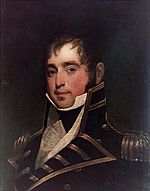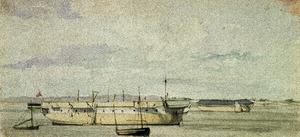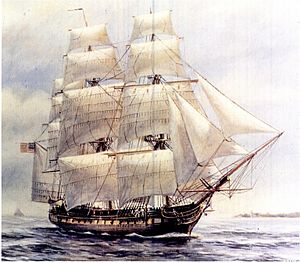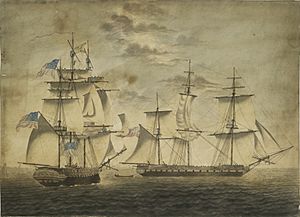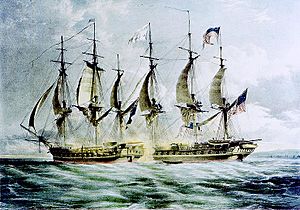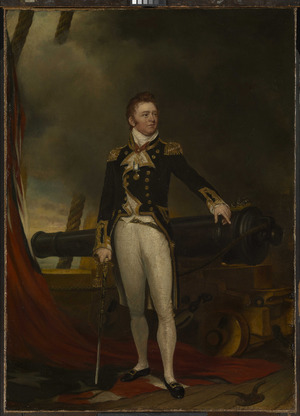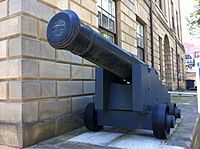Capture of USS Chesapeake facts for kids
Quick facts for kids Capture of USS Chesapeake |
|||||||
|---|---|---|---|---|---|---|---|
| Part of the War of 1812 | |||||||
 Battle between the English [sic] frigate Shannon and the American frigate Chesapeake, Christoffer Wilhelm Eckersberg (1836) |
|||||||
|
|||||||
| Belligerents | |||||||
| Commanders and leaders | |||||||
| Strength | |||||||
| 1 frigate | 1 frigate | ||||||
| Casualties and losses | |||||||
|
|
||||||
The capture of USS Chesapeake, also known as the Battle of Boston Harbor, was fought on 1 June 1813, between the Royal Navy frigate HMS Shannon and the United States Navy frigate USS Chesapeake, as part of the War of 1812 between the United States and the United Kingdom. The Chesapeake was captured in a brief but intense action in which 71 men were killed. This was the only frigate action of the war in which there was no preponderance of force on either side.
At Boston, Captain James Lawrence took command of Chesapeake on 20 May 1813, and on 1 June, put to sea to meet the waiting HMS Shannon, commanded by Captain Philip Broke. Broke had issued a written challenge to Chesapeake's commander, but Chesapeake had sailed before it was delivered.
Chesapeake suffered heavily in the exchange of gunfire, having her wheel and fore topsail halyard shot away, rendering her unmanoeuvrable. Lawrence himself was mortally wounded and was carried below. The American crew struggled to carry out their captain's last order, "Don't give up the ship!", with the British boarding party quickly overwhelming them. The battle was notably intense but of short duration, lasting ten to fifteen minutes, in which time 226 men were killed or wounded. Shannon's captain was severely injured in fighting on the forecastle, but survived his wounds.
Chesapeake and her crew were taken to Halifax, Nova Scotia, where the sailors were taken to prisoner-of-war camps; the ship was repaired and taken into service by the Royal Navy. She was sold at Portsmouth, England, in 1819 and broken up. Surviving timbers were used to build the nearby Chesapeake Mill in Wickham and can be seen and visited to this day. Shannon survived longer, being broken up in 1859.
Contents
Prelude
During his long period in command of Shannon, Captain Philip Broke of the Royal Navy introduced many practical refinements to his 'great guns', which were virtually unheard of elsewhere in contemporary naval gunnery. He had 'dispart sights' fitted to his 18-pounder long guns, which improved aiming as they compensated for the narrowing of the barrels from the breech to the muzzle. He had adjustable tangent sights that would give accuracy at different ranges. He had the elevating 'quoins' (wedge-shaped pieces of wood placed under the breech) of his long guns grooved to mark various degrees of elevation so that his guns could be reliably levelled to fire horizontally in any state of heeling of the ship under a press of sail. The carronades were similarly treated, but the elevating screws on these cannon were marked in paint. As the decks of contemporary ships curved upwards towards the stern and bows, he cut down the wheels on the "up-slope" side of each cannon's carriage in order that all guns were level with the horizon. He also introduced a system where bearings were incised into the deck next to each gun; fire could then be directed to any bearing independent of the ability of any particular gun crew to see the target. Fire from the whole battery could also be focused on any part of an enemy ship.
Broke drilled his crew to an extremely high standard of naval gunnery; he regularly had them fire at targets, such as floating barrels. Often these drills would be made into competitions to see which gun crew could hit the target first and how fast they could do so. He even had his gun crews fire at targets 'blindfold' to good effect; they were only given the bearing to lay their gun on without being allowed to sight the gun on the target themselves. This constituted a very early example of 'director firing'.
In addition to these gunnery drills, Broke was fond of preparing hypothetical scenarios to test his crew. For example, after all hands had been drummed to quarters, he would inform them of a theoretical attack and see how they would act to defend the ship. Though the use of cutlasses in training was avoided, a method of swordsmanship training called 'singlestick' was regularly practiced. This was a game employing roughly similar cuts, thrusts and parries as were used with the cutlass, but as it was played with wooden sticks with wicker hand guards; hits, although painful, were not often dangerous. It soon developed quickness of eye and wrist. Many of the crew became very expert.
James Lawrence
Commander Lawrence of the United States Navy returned from a successful war cruise having defeated the sloop HMS Peacock. He was promoted to captain for his victory, and received orders to take command of USS Chesapeake. It was not a command that he particularly wanted. He had hoped for the larger frigate USS Constitution instead. Lawrence travelled to Boston. He found that most of the former crew of Chesapeake had left over a dispute over prize money and had since been replaced. Lawrence's prior experience of the British Navy worked against him. In his former battle with HMS Peacock, the warship had been bravely fought, but the British gunnery had been nothing less than atrocious. His crew was laden with good seamen; however, they lacked the time working together that was needed to change a collection of good seamen into an efficient fighting crew. Lawrence's assumptions concerning the poor quality of the opposition would leave him over-confident in facing the adversary he was about to encounter.
Issuing a challenge
Eager to engage and defeat one of the American frigates that had already scored a number of victories over the Royal Navy in single-ship confrontations, Broke prepared a challenge. USS President had already slipped out of the harbour under the cover of fog and had evaded the British. Constitution was undergoing extensive repairs and alterations and would not be ready for sea in the foreseeable future. However, Chesapeake appeared to be ready to put to sea. Consequently, Broke decided to challenge Chesapeake, which had been refitting in Boston harbour under the command of Captain James Lawrence, offering single ship-to-ship combat. Whilst patrolling offshore, Shannon had intercepted and captured a number of American ships attempting to reach the harbour. After sending two of them off to Halifax, he found that his crew was being dangerously reduced. Broke therefore resorted to burning the rest of the prizes in order to conserve his highly trained crew in anticipation of the battle with Chesapeake. The boats from the burnt prizes were sent into Boston, carrying Broke's oral invitation to Lawrence to come out and engage him. Broke had already sent Tenedos away in the hope that the more favourable odds would entice the Americans out, but eventually began to despair that Chesapeake would ever come out of the harbour. He finally decided to send a written challenge. In this he was copying his adversary. Lawrence had earlier in the war, when captain of the sloop of war Hornet, sent a written invitation to the captain of the British sloop of war Bonne Citoyenne to a single-ship contest. Lawrence's offer had been declined.
As the Chesapeake appears now ready for sea, I request you will do me the favour to meet the Shannon with her, ship to ship, to try the fortune of our respective flags. The Shannon mounts twenty-four guns upon her broadside and one light boat-gun; 18 pounders upon her maindeck, and 32-pounder carronades upon her quarterdeck and forecastle; and is manned with a complement of 300 men and boys, beside thirty seamen, boys, and passengers, who were taken out of recaptured vessels lately. I entreat you, sir, not to imagine that I am urged by mere personal vanity to the wish of meeting the Chesapeake, or that I depend only upon your personal ambition for your acceding to this invitation. We have both noble motives. You will feel it as a compliment if I say that the result of our meeting may be the most grateful service I can render to my country; and I doubt not that you, equally confident of success, will feel convinced that it is only by repeated triumphs in even combats that your little navy can now hope to console your country for the loss of that trade it can no longer protect. Favour me with a speedy reply. We are short of provisions and water, and cannot stay long here.
Captain Lawrence did not in fact receive Broke's letter and, according to author Ian W. Toll, it would not have made the slightest difference; Lawrence intended to sail USS Chesapeake at the first day of favourable weather. The fact that it was not in his nation's interests at this point in the war to be challenging British frigates seems to have not entered into his reasoning. When USS President had slipped out of harbor, it was to embark on a commerce-raiding mission, which was deemed in the U.S. national interest. Half of the officers and up to one quarter of the crew were new to the ship. In the short time, he was in command of the Chesapeake, Lawrence had twice exercised his crew at the great guns, walking the decks and personally supervising the drill. He also instigated a signal, a bugle call, to call on his crew to board an enemy vessel. Unfortunately the only crew member able to produce a note on the bugle was a "dull-witted" 'loblolly boy' (surgeon's assistant) called William Brown. Lawrence believed that he would win the battle and wrote two quick notes, one to the Secretary of the Navy pronouncing his intentions, and another to his brother in-law asking him to look after Lawrence's wife and children in event of his death.
Bostonians and their neighbours anticipated great results from the celebrated Lawrence and his crew. Local authorities reserved a space at the docks in expectation of accommodating the captured British man-of-war. Also plans were set in motion for a gala victory banquet. As the American warship moved down the harbour, citizens raced to vantage points to witness the fight. Crowds gathered on available heights from Lynn to Malden and from Cohasset to Scituate. A diarist likened the Salem crowds to swarms of bees. The more daring took to boats to follow the Chesapeake. A Boston newspaper reported the bay being covered with civilian craft of all kinds.
HMS Shannon had been off Boston for 56 days and was running short of provisions, whilst the extended period at sea was wearing the ship down. She would be at a disadvantage facing USS Chesapeake, fresh from harbour and a refit. A boat was despatched carrying the invitation, manned by a Mr Slocum, a discharged American prisoner. The boat had not reached the shore when Chesapeake was seen underway, sailing out of the harbour. She was flying three American ensigns and a large white flag at the foremast inscribed 'Free Trade and Sailor's Rights'. Shannon carried 276 officers, seamen and marines of her proper complement, eight recaptured seamen, 22 Irish labourers who had been 48 hours in the ship, of whom only four could speak English, and 24 boys, of whom about 13 were under 12 years of age. Broke had trained his gun crews to fire accurate broadsides into the hulls of enemy vessels, with the aim of killing their gun crews, rather than attempting to disable the enemy ship by firing at the masts and rigging. This was, however, the standard Royal Navy practice of the time, only Broke's efficiency in gunnery training distinguished him in this regard. Lawrence, meanwhile, was confident in his ship, especially since she carried a substantially larger crew. Previous American victories over Royal Navy ships left him expectant of success. Just before the engagement, the American crew gave three cheers.
The two ships were about as close a match in size and force as was possible, given the variations in ship design and armament existing between contemporary navies. USS Chesapeake's (rated at 38 guns) armament of 28 18-pounder long guns was an exact match for HMS Shannon. Measurements proved the ships to be about the same deck length, the only major difference being the ships' complements: Chesapeake's 379 against the Shannon's 330.
| HMS Shannon | USS Chesapeake | |
|---|---|---|
| Length (gundeck) | 150 ft 2 in (45.77 m) | 151 ft 0 in (46.02 m) |
| Beam | 39 ft 11 in (12.17 m) | 40 ft 11 in (12.47 m) |
| Tonnage | 1065 tons | 1135 tons |
| Complement | 330 men | 379 men |
| Armament | 28 × 18-pounder long guns 20 × 32-pounder carronades 1 × 18-pounder chase gun |
* Broke shipped the smaller calibre guns (6-pounder, and 12-pounder carronade) in order that the younger midshipmen and ship's boys had light-weight ordnance that they could practise all aspects of gun laying and firing with.
Battle
Gunnery duel
As the American ship approached, Broke spoke to his crew, ending with a description of his philosophy of gunnery, "Throw no shot away. Aim every one. Keep cool. Work steadily. Fire into her quarters – maindeck to maindeck, quarterdeck to quarterdeck. Don't try to dismast her. Kill the men and the ship is yours."
The two ships met at half past five in the afternoon, 20 nautical miles (37 km) east of the Boston Light, between Cape Ann and Cape Cod. Shannon was flying a weather-worn blue ensign, and her dilapidated outside appearance after a long period at sea suggested that she would be an easy opponent. Observing the Chesapeake's many flags, a sailor had questioned Broke: "Mayn't we have three ensigns, sir, like she has?" "No," said Broke, "we've always been an unassuming ship." HMS Shannon refused to fire upon USS Chesapeake as she bore down, nor did USS Chesapeake attempt to rake HMS Shannon, despite having the weather gage. Lawrence's behaviour that day earned him praise from the British officers for gallantry.
The two ships opened fire just before 18:00 at a range of about 35 metres (115 ft), with Shannon scoring the first hit, striking Chesapeake on one of her forward gunports with two round shot and a bag of musket balls fired by William Mindham, the gun captain of the aftmost of Shannon's starboard 18-pounders. Chesapeake was moving faster than Shannon, and as she ranged down the side of the British ship, the destruction inflicted by the precise and methodical gunnery of the British crew moved aft with the American's forward gun crews suffering the heaviest losses. However, the American crew were well drilled and, despite their losses, returned fire briskly. As Chesapeake was heeling, many of their shots struck the water or waterline of Shannon causing little damage, but American carronade fire caused serious damage to Shannon's rigging. In particular, a 32-pound carronade ball struck the piled shot for the Shannon's 12-pounder gun that was stowed in the main chains; the shot was propelled through the timbers to scatter like hail across the gundeck.
As the distance closed, the Shannon's gun crews and topmen kept up a relentless fire, and the unprotected quarter-deck became as uninhabitable as the surface of the moon.
Captain Lawrence realised that his ship's speed would take it past Shannon and ordered a 'pilot's luff'. This was a small and brief turn to windward which would make the sails shiver and reduce the ship's speed. Just after Chesapeake began this limited turn away from Shannon, she had her means of manoeuvring entirely disabled as a second round of accurate British fire caused more losses, most critically to the men and officers manning Chesapeake's quarterdeck. Here the helmsmen were killed by a 9-pounder gun that Broke had ordered installed on the quarter deck for that very purpose, and the same gun shortly afterwards shot away the wheel itself. Surviving American gun crews did land hits on Shannon in their second round of fire, especially American carronade fire which swept Shannon's forecastle, killing three men, wounding others and disabling Shannon's forward 9-pounder gun while one round shot demolished Shannon's ship's bell.
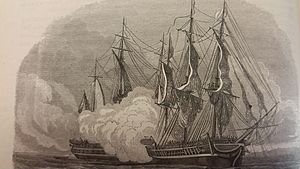
At almost the same time as Chesapeake lost control of her helm, her fore-topsail halyard was shot away, her fore-topsail yard then dropped, and she 'luffed up'. Losing her forward momentum, she yawed further into the wind until she was 'in irons', her sails were pressed back against her masts and she then made sternway (went backwards). Her port stern quarter (rear left corner) made contact with Shannon's starboard side, level with the fifth gunport from the bow, and Chesapeake was caught by the projecting fluke of one of Shannon's anchors, which had been stowed on the gangway. Chesapeake's spanker boom then swung over the deck of the British ship. Mr Stevens, Shannon's boatswain, lashed the boom inboard to keep the two ships together, and lost an arm as he did so.
Trapped against Shannon at an angle in which few of her guns could fire on the British ship, and unable to manoeuvre away, Chesapeake's stern now became exposed and was swept by raking fire. Earlier in the action Shannon's gunnery had devastated Chesapeake's forward gun crews; this destruction was now inflicted on the gun crews in the aft part of the ship. The American ship's situation worsened when a small open cask of musket cartridges abaft the mizzen-mast blew up. When the smoke cleared, Broke judged the time was right and gave the order to board. Captain Lawrence also gave the order to board, but the frightened bugler aboard Chesapeake, William Brown, failed to sound the call, and only those near Lawrence heard his command. By this time Lawrence was the only officer left on the upper deck, as Lieutenants Ludlow and Ballard had been wounded. Lieutenant Cox, who had brought up men from the lower deck to form a boarding party, reached the quarterdeck only to find that his captain had been badly, indeed mortally, wounded by musket fire. Lawrence was clinging to the binnacle in order to stay upright; Cox, who had served all his sea life with Lawrence, carried him down to the cockpit with the help of two sailors. As he was being taken down Lawrence called out "Tell the men to fire faster! Don't give up the ship!"
The British board
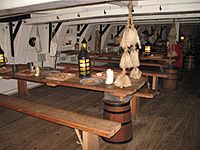
In contrast to the confusion and loss of leadership aboard the American vessel, the British boarding party was being effectively organised. A number of small-arms men rushed aboard Chesapeake, led by Broke, including the purser, Mr G. Aldham, and the clerk, Mr John Dunn. Aldham and Dunn were killed as they crossed the gangway, but the rest of the party made it onto Chesapeake. Captain Broke, at the head of not more than twenty men, stepped from the rail of the waist-hammock netting onto the muzzle of the port-side carronade of Chesapeake closest to the stern, and from there he jumped down to her quarterdeck. As the British boarded there were no American officers left on the quarterdeck to organise resistance.
The maindeck of Chesapeake was almost deserted, having been swept by Shannon's gunfire; the surviving gun crews had either responded to the call for boarders or had taken refuge below. Two American officers, Lieutenant Cox (who had returned from carrying Captain Lawrence down to the surgeon) and Midshipman Russell saw that the aftmost 18-pounders on the port side still bore on Shannon. Working between them, they managed to fire both.
Lieutenant Ludlow, who had been slightly wounded and had gone down to Chesapeake's cockpit for treatment, now returned to the upper decks, rallying some of the American crew as he did so. Lieutenant Budd joined him with a band of men he had led up the fore-hatch. Ludlow led them in a counter-attack which pushed the British back as far as the binnacle. However, a wave of British reinforcements arrived, Ludlow received a mortal wound from a cutlass, and the Americans were again thrown back. James Bulger, one of Shannon's Irishmen, charged into the Americans wielding a boarding pike and shouting Gaelic curses – "And then did I not spit them, beJaysus!" Lacking officers to lead them (Lieutenant Budd had also been wounded by a cutlass) and lacking support from below, the Americans were driven back by the boarders. American resistance then fell apart, with the exception of a band of men on the forecastle and those in the tops. A number of the Americans driven from the upper decks jostled each other to get down the main hatchway to the comparative safety of the berth deck.
Fighting had also been ongoing between the tops (platforms at the junction of mast and topmast) of the ships, as rival sharpshooters fired upon their opponents and upon sailors on the exposed decks below. While the ships were locked together, the British marksmen, led by midshipman William Smith, commander of the fore-top, stormed Chesapeake's fore-top over the yard-arm and killed all the Americans there. Following this, the wind tore the two ships apart, and Chesapeake was blown around the bows of Shannon. This left the British boarders, about fifty-strong, stranded. However, organised resistance aboard the American ship had almost ceased by this time.
Broke himself led a charge against a number of the Americans who had managed to rally on the forecastle. Three American sailors, probably from the rigging, descended and attacked him. Taken by surprise, he killed the first, but the second hit him with a musket which stunned him, whilst the third sliced open his skull with his sabre, knocking him to the deck. Before the sailor could finish Broke off, the American was bayoneted by a British Marine named John Hill. Shannon's crew rallied to the defence of their captain and carried the forecastle, killing the remaining Americans. Broke sat, dizzied and weak, on a carronade slide, and his head was bound up by William Mindham, who used his own neckerchief. One of Shannon's lieutenants, Provo Wallis, believed that Broke's three assailants were probably British deserters. The desperate and violent attempt on Broke's life made by these men may have been motivated by the fact that they faced the death penalty under the Royal Navy's Articles of War as deserters. Meanwhile, Shannon's First Lieutenant, Mr George T. L. Watt, had attempted to hoist the British colours over Chesapeake's, but this was misinterpreted aboard Shannon, and he was hit in the forehead by grapeshot and killed as he did so.
Chesapeake is taken
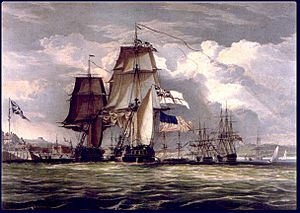
The British had cleared the upper decks of American resistance, and most of Chesapeake's crew had taken refuge on the berth deck. A musket or pistol shot from the berth deck killed a British marine, William Young, who was guarding the main hatchway. The furious British crewmen then began firing through the hatchway at the Americans crowded below. Lieutenant Charles Leslie Falkiner of Shannon, the leader of the boarders who had rushed the maindeck, restored order by threatening to blow out the brains of the next person to fire. He then demanded that the Americans send up the man who had killed Young, adding that Chesapeake was taken and "We have three hundred men aboard. If there is another act of hostility you will be called up on deck one by one – and shot." Falkiner was given command of Chesapeake as a British prize-vessel.
Shannon's midshipmen during the action were Messers, Smith, Leake, Clavering, Raymond, Littlejohn and Samwell. Samwell was the only British officer other than Broke to be wounded in the action; he was to die from an infection of his wounds some weeks later. Mr Etough was the acting master, and conned the ship into the action. Shortly after Chesapeake had been secured, Broke fainted from loss of blood and was rowed back to Shannon to be attended to by the ship's surgeon.
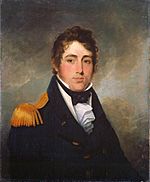
The engagement had lasted just ten minutes according to Shannon's log, or eleven minutes by Lieutenant Wallis' watch. Broke more modestly claimed fifteen minutes in his official despatch. Shannon had lost 23 men killed, and had 56 wounded. Chesapeake had about 48 killed, including four lieutenants, the master and many other of her officers, and 99 wounded. Shannon had been hit by a total of 158 projectiles, Chesapeake by 362 (these figures include grapeshot). In the time the batteries of both ships were firing, the Americans had been exposed to 44 roundshot, whilst the British had received 10 or 11 in reply (these are figures for shot which would have produced casualties or material damage; some of Chesapeake's shot was fired low, bouncing off Shannon's side at waterline level). Even before being boarded, Chesapeake had lost the gunnery duel by a considerable margin.
A large cask of un-slaked lime was found open on Chesapeake's forecastle, and another bag of lime was discovered in the fore-top. Some British sailors alleged the intention was to throw handfuls into the eyes of Shannon's men in an unfair and dishonourable manner as they attempted to board, though that was never done by Chesapeake's crew. Historian Albert Gleaves has called the allegation "absurd," noting, "Lime is always carried in ship's stores as a disinfectant, and the fact that it was left on the deck after the ship was cleared for action was probably due to the neglect of a junior, or petty, officer."
Aftermath
After the victory, a prize crew was put aboard Chesapeake. The commander of the prize, Lieutenant Falkiner, had a good deal of trouble from the restive Americans, who outnumbered his own men. He had some of the leaders of the unrest transferred to Shannon in the leg-irons that had, ironically, been shipped aboard Chesapeake to deal with expected British prisoners. The rest of the American crew were rendered docile by the expedient of a carpenter cutting scuttles (holes) in the maindeck through which two 18-pounder cannon, loaded with grapeshot, were pointed at them.
Shannon, commanded by Lieutenant Provo Wallis, escorted her prize into Halifax, arriving there on 6 June. On the entry of the two frigates into the harbour, the naval ships already at anchor manned their yards, bands played martial music and each ship Shannon passed greeted her with cheers. The 320 American survivors of the battle were interned on Melville Island in 1813, and their ship, taken into British service and renamed HMS Chesapeake, was used to ferry prisoners from Melville Island to England's Dartmoor Prison. Many officers were paroled to Halifax, but some began a riot at a performance of a patriotic song about Chesapeake's defeat. Parole restrictions were tightened: beginning in 1814, paroled officers were required to attend a monthly muster on Melville Island, and those who violated their parole were confined to the prison.

As the first major naval victory in the war of 1812 for the British, the capture raised the morale of the Royal Navy. After setting out on 5 September for a brief cruise under a Captain Teahouse, Shannon departed for England on 4 October, carrying the recovering Broke. They arrived at Portsmouth on 2 November. After the successful action, Lieutenants Wallis and Falkiner were promoted to the rank of commander, and Messrs. Etough and Smith were made lieutenants. Broke was made a Baronet that September. The Court of Common Council of London awarded him the freedom of the city and a sword worth 100 guineas. He also received a piece of plate worth 750 pounds and a cup worth 100 guineas. Captain Lawrence was buried in Halifax with full military honours, six British Naval Officers served as pall bearers. Chesapeake, after active service in the Royal Navy, was eventually sold at Portsmouth, England, for £500 in 1819 and broken up. Some of the timbers of Chesapeake were used in the construction of the Chesapeake Mill in Wickham, Hampshire. Shannon was reduced to a receiving ship in 1831, and broken up in 1859.
In the US, the capture was seen as a humiliation, and contributed to popular sentiment against the war. Many New Englanders, now calling the conflict "Madison's war" after James Madison, demanded that he resign the presidency.
In a war that reached new lows for historical accuracy sacrificed in the name of patriotic fervour, accounts of Shannon's victory would be ascribed to many reasons. Very few of these took into account that Lawrence had rushed into a fight with an untrained and unprepared crew for what awaited him. Theodore Roosevelt would later state this plainly, lambasting former American "history writers" while doing so. In less than 2 minutes Shannon's crew had taken horrible losses and did not break, while Chesapeake's crew did. Unfortunately for Lawrence, he did not meet an average British frigate of this point in the long wars, undermanned and with many men aboard who were not real seamen, but a frigate with a crew at the highest pitch of training, led by an expert in naval gunnery. It has been said of Shannon, that "a more destructive vessel of her force had probably never existed in the history of naval warfare".
Broke never again commanded a ship. The head wound from a cutlass blow, which had exposed the brain, had been very severe accompanied by great blood loss. Therapeutic bleeding, routinely employed at the time, was not performed by Shannon's surgeon Mr Alexander Jack, which was to Broke's advantage. The report of the surgeon described the wound as "a deep cut on the parietal bone, extending from the top of the head ... towards the left ear, [the bone] penetrated for at least three inches in length". Broke survived the wound into moderate old age (64 years), though he was debilitated. He suffered, to a greater or lesser extent, from headaches and other neurological problems for the rest of his life. The casualties were heavy. The British lost 23 killed and 56 wounded. The Americans lost 48 killed and 99 wounded. Between the wounded of the ships' two companies, another 23 died of their wounds in the two weeks following the action. Relative to the total number of men participating, this was one of the bloodiest ship-to-ship actions of the age of sail. By comparison, HMS Victory suffered fewer casualties during the whole of the Battle of Trafalgar. The entire action had lasted, at most, for 15 minutes, speaking to the ferocity of the fighting.
A sister ship of HMS Shannon has been restored and preserved, HMS Trincomalee of the Leda class; she can be seen in a dock at Hartlepool in the North East of England and is the oldest British warship afloat.
In fiction
The capture of USS Chesapeake by HMS Shannon features prominently in The Fortune of War, the sixth book in the Aubrey–Maturin series of historical fiction novels by Patrick O'Brian, and first published in 1979. The main characters, having escaped Boston as prisoners of war, are on board the Shannon during the engagement. The battle is described with considerable accuracy by O'Brian, with his fictional characters playing only minor roles in the action.
The battle is mentioned in chapter 12 of the science fiction novel Starship Troopers by Robert A. Heinlein, and was also referred to in the novel Anne of the Island by Lucy Maud Montgomery.



